The Huawei MateBook 16 Review, Powered by AMD Ryzen 7 5800H: Ecosystem Plus
by Dr. Ian Cutress on October 20, 2021 8:00 AM EST- Posted in
- Laptops
- AMD
- Huawei
- Matebook
- Ryzen
- Zen 3
- MateBook 16
- Huawei Share
- Ryzen 7 5800H
Power and Storage Performance
The processors used in the MateBook 16 are the latest Zen 3 based AMD Ryzen Mobile parts that exist as part of AMD’s H-Series range. The H-series, both on the side of AMD and Intel, typically run with a 45 W thermal design power (TDP) by definition, although depending on the mobile device being used, the manufacturers can adjust that TDP either up or down, given the desired cooling, performance, and battery life.
| AMD Ryzen 5000 Mobile: H-Series | |||||
| AnandTech | Cores Threads |
Base Freq |
Boost Freq |
TDP Default |
Vega |
| Ryzen 9 5980HX | 8C / 16T | 3300 | 4800 | 45W+ | Vega 8 |
| Ryzen 9 5980HS | 8C / 16T | 3000 | 4800 | 35W | Vega 8 |
| Ryzen 9 5900HX | 8C / 16T | 3300 | 4600 | 45W+ | Vega 8 |
| Ryzen 9 5900HS | 8C / 16T | 3000 | 4600 | 35W | Vega 8 |
| Ryzen 7 5800H | 8C / 16T | 3200 | 4400 | 45W | Vega 8 |
| Ryzen 7 5800HS | 8C / 16T | 2800 | 4400 | 35W | Vega 8 |
| Ryzen 5 5600H | 6C / 12T | 3300 | 4200 | 45W | Vega 7 |
| Ryzen 5 5600HS | 6C / 12T | 3000 | 4200 | 35W | Vega 7 |
Typically the TDP setting of a mobile processor isn’t just a ‘suggestion’ as with some of the desktop hardware: the power limit imposed by the TDP comes up very quickly after a few seconds of heavy loading, or even straight away for the slimmest of designs that are not designed for high thermal hotspots. As a result, we’re in a situation where looking at the processor name on a laptop or notebook means next to nothing for performance, and instead we need to look at the power use in a variety of scenarios. One day I hope that laptop vendors will list the configured power window for the processors they have tuned, but I don’t see it coming any time soon.
In this case, Huawei is using the Ryzen 7 5800H in our MateBook 16 unit: an 8-core, 16-thread processor with Vega 8 graphics. It has a nominal thermal design power of 45 W, but Huawei has configured it to run at 35 W. When run in this mode, the turbo frequencies are usually the same as the higher power mode, but when the system clamps on the maximum power, the all-core frequency is reduced to get to that level. The added bonus of this, aside from maintaining comfortable thermals on the device, is also that the processor runs nearer its peak efficiency point.
Huawei further spices it up by offering a PERFORMANCE mode. If the laptop is plugged into the wall with its 135 W charger, performance mode can be activated which allows individual cores access to the full 35 W. In all-core use, we see that the turbo time is increased, keeping the whole processor at 35 W for longer. The goal here is extra long-term performance, which we see in our testing in benchmarks that are long and compute-heavy, although we fail to see much benefit in gaming or day-to-day tasks.
To showcase this, we start with a traditionally heavy workload in Prime 95.
In this test, the Performance mode spikes at 52 W when the test begins, but then very quickly comes down to 35 W, which it continues all the way to the end of the test. By contrast, in the default balanced mode, we get 35 W for about 3 minutes, and then the processor scales back to 30 W.
Interestingly enough, we don’t see the same issue in Handbrake:
In this case both processors perform equally for the duration of the test, staying at 35 W, except for that initial 57 W spike when in performance mode. The test in this case took an identical amount of time to complete.
Agisoft is one of my tests that is more varied in the threaded workload, with a mix of all-core and single core tasks, and we see a can see a considerable different in the performance between the two modes.
I’ve adjusted the x-axis to % of benchmark complete, because the Performance mode completes the test about 6% quicker.
Here we see that the Performance mode stays at 35 W for most of the test, until the last 15% which is more single-threaded. The Balanced mode gets knocked back almost immediately to 30 W, before reducing further to 20 W. The whole test takes around 20 minutes, and the Balanced came down to 20 W around the 14-minute mark. But overall, the performance mode was quicker, at the expense of extra power.
Storage Performance
The MateBook 16, regardless of which model you buy, will come with 16 GB of DDR4-3200 and a 512 GB NVMe SSD inside. The storage in our laptop is a Samsung PM981a, which is the same PCIe 3.0 x4 drive that Huawei has been putting inside its laptops for at least two generations, if not three. It’s still a good performer, and compared to the 1 TB version we saw in the MateBook X Pro in our previous review, it is a tiny bit faster.
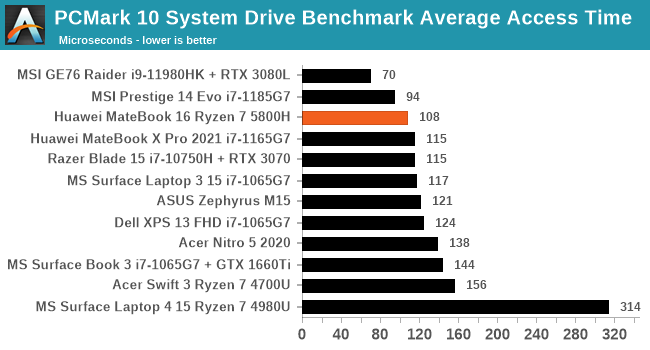
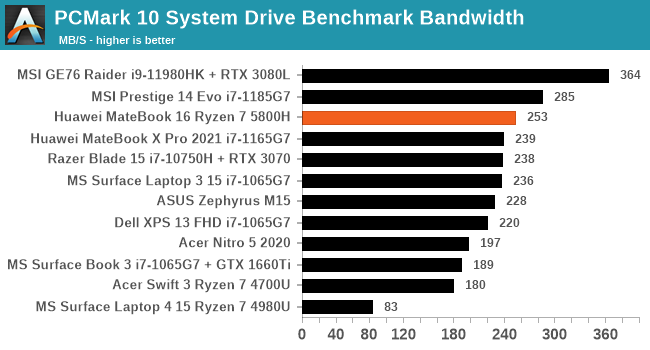
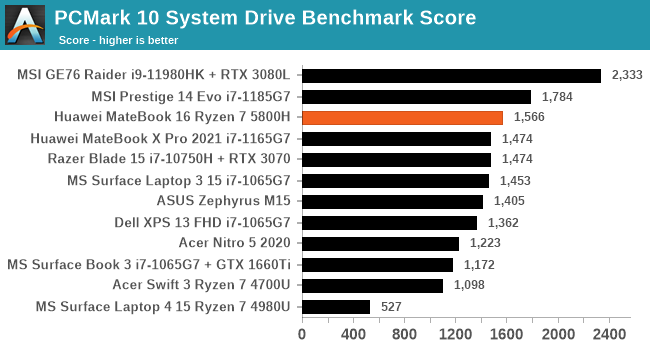
While Huawei continues to use the lowest SKU of the respective stack, such as the lowest Core i7 in the Core i7-1165G7 for the MateBook X Pro and the lowest Ryzen 7 for the Ryzen 7 5800H in the MateBook 16, there isn’t much reason for them to use anything other than the PM981a, as it remains a good drive.


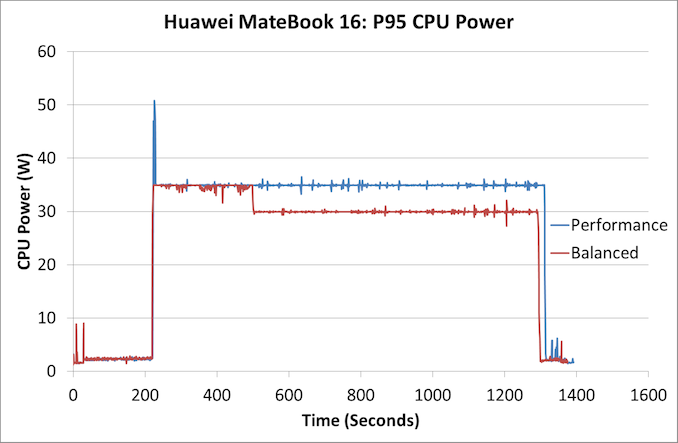
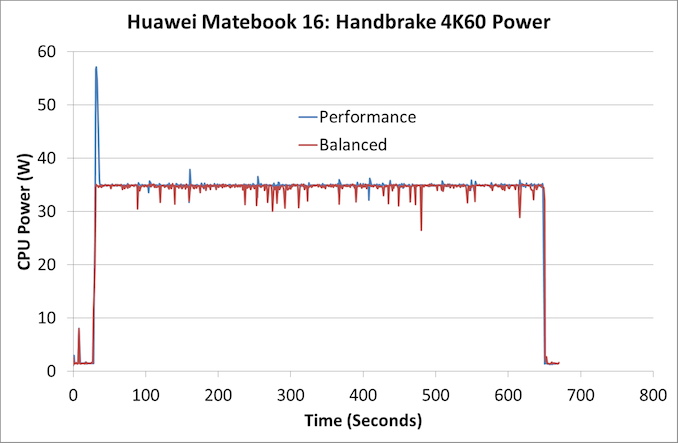
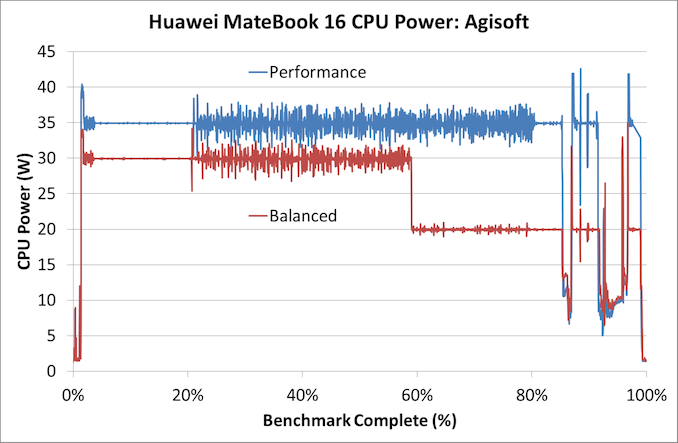








87 Comments
View All Comments
Oxford Guy - Sunday, October 24, 2021 - link
640K ought to be enough for anybody.Oxford Guy - Sunday, October 24, 2021 - link
'I'm amazed companies keep pushing laptops with 512GB SDDs and pretend they are not crap. 1 TB of storage is the absolute minimum any new pc or laptop should have if you don't want to buy a second SSD in a few months.'Agreed. Companies think they can be Apple.
Alistair - Wednesday, October 20, 2021 - link
Won't buy anything from Huawei again. They are basically the Chinese military and are heavily connected to top leadership in China. They abducted two innocent Canadian citizens for 3 years and mistreated them. My current Huawei phone will be the last product I ever buy from them, that's for sure. Don't support evil.abufrejoval - Wednesday, October 20, 2021 - link
Let's not forget that without top military connections, Silicon Valley would not have happened.I couldn't really stop buying hardware from a country run by a narcicistic would-be dictator either, nor are there many ways around a company from that country, which now seems quite more ready to "do evil".
Since I was born in the city where Konrad Zuse invented the programmable computer to help Adolf win The War, I just hope that sooner or later the other millions or billion citizen come to their senses without civil or even less civil war.
Alistair - Wednesday, October 20, 2021 - link
China today, we are talking about a company right now, a government, right now, 2021. You can buy products from other brands like Samsung, or Adata, Asus, or Acer.Oxford Guy - Sunday, October 24, 2021 - link
Glenn Greenwald, in his 'collapsing empire' piece at Salon, said the US is the world's largest dealer of arms.Last time I checked, arms are used to rob people of theirs.
Alistair - Wednesday, October 20, 2021 - link
Also you should wake up, suggesting China is comparable to any modern country is just ignorant. Taiwan, Korea, and Japan are the major modern Asian countries. Not China, especially politically.TheinsanegamerN - Wednesday, October 20, 2021 - link
The canadian government regularly turned a blind eye to the abuse/murder of natives by the RCMP. Hope you dont buy anything canadian either eh!Alistair - Wednesday, October 20, 2021 - link
That is just anti Canada nonsense.sonny73n - Thursday, October 21, 2021 - link
You must be one of them racist and prejudice KKK in the US. I don't ever hear any Chinese slander you people but somehow you people keep spewing shit everyday. Chinese people in general are much more decent than you scumbag.Yea in China some company is state sponsored but in your country, big corps sponsor the state. You know what does that mean, don't you?